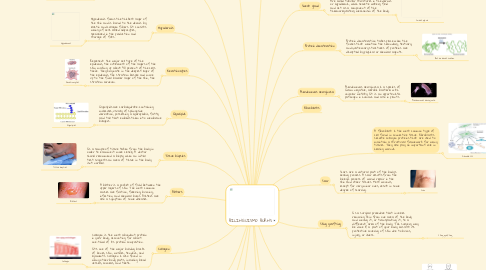
1. Epidermis
1.1. The Epidermis is the outermost layer of our skin. It is located above the dermis and is formed almost exclusively by epithelial cells of the keratinocyte type.
1.1.1. Epidermis
2. Dermis
2.1. Inner layer of the two main layers of the skin. The dermis has connective tissue, blood vessels, sebaceous and sweat glands, nerves, hair follicles, and other structures. It is composed of a thin upper layer called papillary dermis and a thick bottom layer called reticular dermis.
2.1.1. Dermis
3. Hypodermis
3.1. Hypodermis forms the thickest layer of the skin and is bound to the dermis by elastin and collagen fibers. It consists mainly of cells called adipocytes, specialized in the production and storage of fats.
3.1.1. Hypodermis
4. Keratinocytes
4.1. Represent the major cell type of the epidermis, the outermost of the layers of the skin, making up about 90 percent of the cells there. They originate in the deepest layer of the epidermis, the stratum basale and move up to the final barrier layer of the skin, the stratum corneum.
4.1.1. Keratinocytes
5. Glycolipids
5.1. Glycolipids are carbohydrate-containing molecules, usually of sphingosine derivation, possessing a hydrophobic, fatty acid tail that embeds them into membrane bilayers.
5.1.1. Glycolipids
6. Tissue biopsies
6.1. Is a sample of tissue taken from the body in order to examine it more closely. A doctor should recommend a biopsy when an initial test suggests an area of tissue in the body isn't normal.
6.1.1. Tissue biopsies
7. Blisters
7.1. A blister is a pocket of fluid between the upper layers of skin. The most common causes are friction, freezing, burning, infection, and chemical burns. Blisters are also a symptom of some diseases.
7.1.1. Blisters
8. Collagen
8.1. Collagen is the most abundant protein in your body, accounting for about one-third of its protein composition. It’s one of the major building blocks of bones, skin, muscles, tendons, and ligaments. Collagen is also found in many other body parts, including blood vessels, corneas, and teeth.
8.1.1. Collagen
9. Cellular damage
9.1. Cell damage (also known as cell injury) is a variety of changes of stress that a cell suffers due to external as well as internal environmental changes
9.1.1. Cellular damage
10. Macrophage
10.1. Are specialised cells involved in the detection, phagocytosis and destruction of bacteria and other harmful organisms. In addition, they can also present antigens to T cells and initiate inflammation by releasing molecules (known as cytokines) that activate other cells.
10.1.1. Macrophage
11. Bibliography
11.1. -Kristensen, J; Karsdal, M.(2016) Biochemistry of Collagens, Laminins and Elastin. Recuperado de https://www.sciencedirect.com/topics/neuroscience/elastin.- Guasch, G.(2017) The Epithelial Stem Cell Niche in Skin. Recuperado de https://www.sciencedirect.com/topics/medicine-and-dentistry/sweat-gland#:~:text=Sweat%20glands%20are%20coiled%20tubular,Pathobiology%20of%20Human%20Disease%2C%202014
12. A fibroblast is the most common type of cell found in connective tissue. Fibroblasts secrete collagen proteins that are used to maintain a structural framework for many tissues. They also play an important role in healing wounds.
12.1. Fibroblasts
13. Degree burns
13.1. First-degree burns
13.1.1. Are considered mild compared to other burns. They result in pain and reddening of the epidermis (outer layer of the skin).
13.1.1.1. first degree burns
13.2. Second-degree burns
13.2.1. (Partial thickness burns) affect the epidermis and the dermis (lower layer of skin). They cause pain, redness, swelling, and blistering.
13.2.1.1. Second degree burns
13.3. Third-degree burns
13.3.1. (Full thickness burns) go through the dermis and affect deeper tissues. They result in white or blackened, charred skin that may be numb.
13.3.1.1. third degree burns
14. Sweat gland
14.1. Are coiled tubular structures in the dermis or hypodermis, which secrete watery fluid and act as a component of the thermoregulatory mechanism of the body.
14.1.1. Sweat gland
15. Elastin
15.1. Has a high content of hydrophobic amino acids and is the major protein of elastic fibers that form a randomly oriented, interconnected fiber system in many tissues.
15.1.1. Elastin
16. Protein denaturation
16.1. Protein denaturation takes place when the forces that maintain the secondary, tertiary, and quaternary structures of proteins are disrupted by physical or chemical agents.
16.1.1. Protein denaturation
17. Fibroblasts
18. Pseudomonas aeruginosa
18.1. Pseudomonas aeruginosa is a species of Gram-negative, aerobic bacteria with unipolar motility. It is an opportunistic pathogen in humans and also in plants
18.1.1. Pseudomonas aeruginosa
19. Scar
19.1. Scars are a natural part of the body's healing process. A scar results from the biologic process of wound repair in the skin and other tissues. Most wounds, except for very minor ones, result in some degree of scarring.
19.1.1. Scar
20. Sking grafting
20.1. Is a surgical procedure that involves removing skin from one area of the body and moving it, or transplanting it, to a different area of the body. This surgery may be done if a part of your body has lost its protective covering of skin due to burns, injury, or illness.
20.1.1. Sking grafting
21. Rule of nines
21.1. The rule of nines is a method doctors and emergency medical providers use to easily calculate the treatment needs for a person who’s been burned.
21.1.1. Rule of nines
22. Infections
22.1. An infection occurs when another organism enters your body and causes disease. The organisms that cause infections are very diverse and can include things like viruses, bacteria, fungi, and parasites.
22.1.1. Infections
